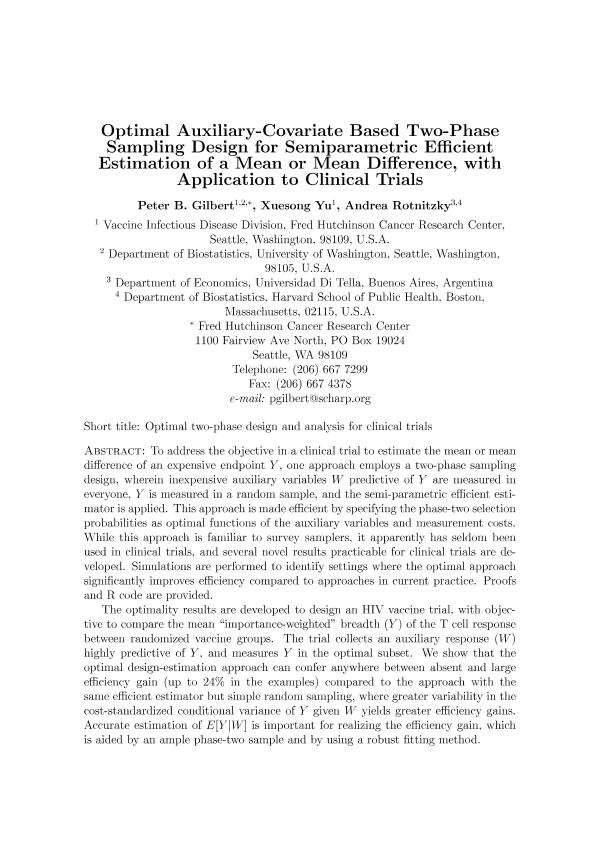Mostrar el registro sencillo del ítem
dc.contributor.author
Gilbert, Peter B.
dc.contributor.author
Yu, Xuesong
dc.contributor.author
Rotnitzky, Andrea Gloria

dc.date.available
2019-11-20T23:10:35Z
dc.date.issued
2014-03
dc.identifier.citation
Gilbert, Peter B.; Yu, Xuesong; Rotnitzky, Andrea Gloria; Optimal auxiliary-covariate-based two-phase sampling design for semiparametric efficient estimation of a mean or mean difference, with application to clinical trials; John Wiley & Sons Ltd; Statistics In Medicine; 33; 6; 3-2014; 901-917
dc.identifier.issn
0277-6715
dc.identifier.uri
http://hdl.handle.net/11336/89356
dc.description.abstract
To address the objective in a clinical trial to estimate the mean or mean difference of an expensive endpoint Y, one approach employs a two-phase sampling design, wherein inexpensive auxiliary variables W predictive of Y are measured in everyone, Y is measured in a random sample, and the semiparametric efficient estimator is applied. This approach is made efficient by specifying the phase two selection probabilities as optimal functions of the auxiliary variables and measurement costs. While this approach is familiar to survey samplers, it apparently has seldom been used in clinical trials, and several novel results practicable for clinical trials are developed. We perform simulations to identify settings where the optimal approach significantly improves efficiency compared to approaches in current practice. We provide proofs and R code. The optimality results are developed to design an HIV vaccine trial, with objective to compare the mean 'importance-weighted' breadth (Y) of the T-cell response between randomized vaccine groups. The trial collects an auxiliary response (W) highly predictive of Y and measures Y in the optimal subset. We show that the optimal design-estimation approach can confer anywhere between absent and large efficiency gain (up to 24 % in the examples) compared to the approach with the same efficient estimator but simple random sampling, where greater variability in the cost-standardized conditional variance of Y given W yields greater efficiency gains. Accurate estimation of E[Y|W] is important for realizing the efficiency gain, which is aided by an ample phase two sample and by using a robust fitting method.
dc.format
application/pdf
dc.language.iso
eng
dc.publisher
John Wiley & Sons Ltd

dc.rights
info:eu-repo/semantics/openAccess
dc.rights.uri
https://creativecommons.org/licenses/by-nc-sa/2.5/ar/
dc.subject
AUGMENTED INVERSE PROBABILITY WEIGHTING
dc.subject
EFFICIENT ESTIMATION
dc.subject
EFFICIENT SAMPLING
dc.subject
MISSING DATA
dc.subject
SEMIPARAMETRIC MODEL
dc.subject
TWO-PHASE SAMPLING
dc.subject.classification
Estadística y Probabilidad

dc.subject.classification
Matemáticas

dc.subject.classification
CIENCIAS NATURALES Y EXACTAS

dc.title
Optimal auxiliary-covariate-based two-phase sampling design for semiparametric efficient estimation of a mean or mean difference, with application to clinical trials
dc.type
info:eu-repo/semantics/article
dc.type
info:ar-repo/semantics/artículo
dc.type
info:eu-repo/semantics/publishedVersion
dc.date.updated
2019-10-28T14:34:13Z
dc.journal.volume
33
dc.journal.number
6
dc.journal.pagination
901-917
dc.journal.pais
Reino Unido

dc.journal.ciudad
Londres
dc.description.fil
Fil: Gilbert, Peter B.. Fred Hutchinson Cancer Research Center; Estados Unidos. University of Washington; Estados Unidos
dc.description.fil
Fil: Yu, Xuesong. Fred Hutchinson Cancer Research Center; Estados Unidos
dc.description.fil
Fil: Rotnitzky, Andrea Gloria. Consejo Nacional de Investigaciones Científicas y Técnicas; Argentina. Universidad Torcuato Di Tella; Argentina. Harvard University. Harvard School of Public Health; Estados Unidos
dc.journal.title
Statistics In Medicine

dc.relation.alternativeid
info:eu-repo/semantics/altIdentifier/doi/http://dx.doi.org/10.1002/sim.6006
dc.relation.alternativeid
info:eu-repo/semantics/altIdentifier/url/https://onlinelibrary.wiley.com/doi/abs/10.1002/sim.6006
Archivos asociados
